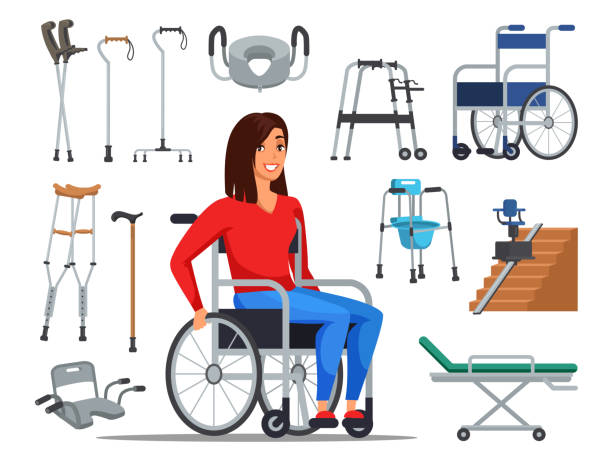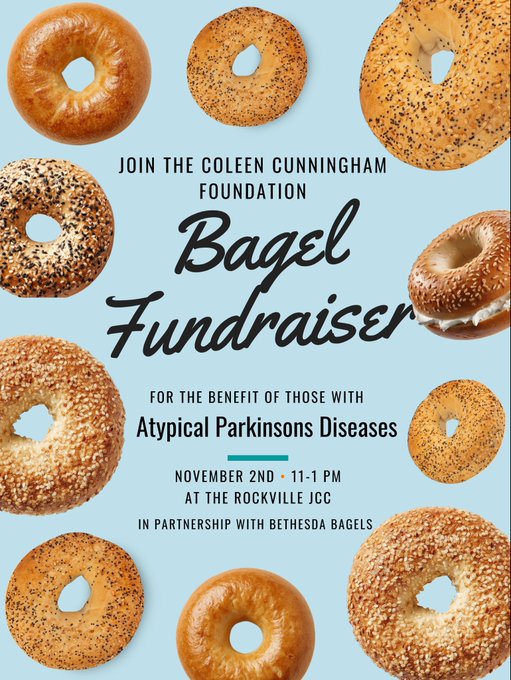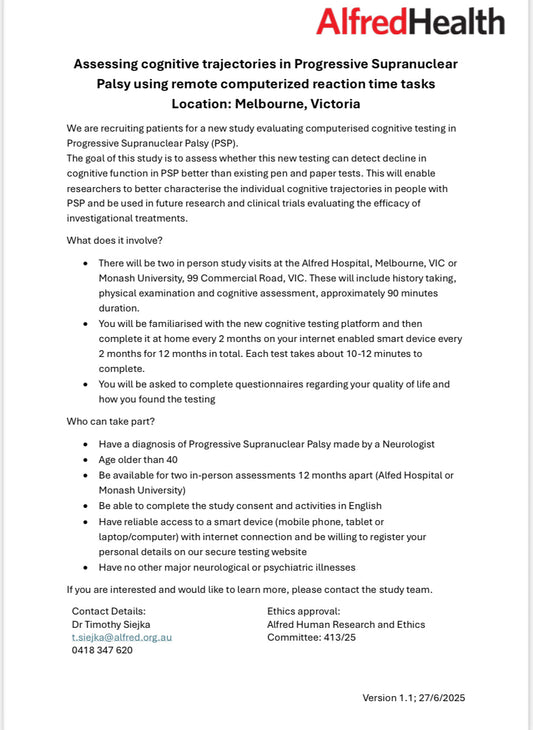Progressive supranuclear palsy (PSP) is a rare neurodegenerative disorder that affects movement, balance, speech, vision, and cognition. As the disease progresses, individuals living with PSP often require assistive devices and mobility aids to help maintain their independence and safety. This comprehensive blog post will discuss a variety of assistive devices, mobility aids, and other items that can help improve the quality of life for individuals with PSP and their caregivers.
Assistive Devices and Mobility Aids for PSP
- Canes and walking sticks
Canes and walking sticks can provide support and stability for individuals with mild to moderate balance and mobility issues. Choosing the appropriate cane or walking stick depends on the individual's needs, preferences, and level of stability.
- Standard canes: These canes have a single point of contact with the ground and are suitable for individuals who require minimal support.
- Quad canes: These canes have a four-pronged base, providing more stability than standard canes and are ideal for individuals who need additional support while walking.
- Walkers and rollators
Walkers and rollators offer more significant support and stability than canes, making them suitable for individuals with more severe balance and mobility challenges.
- Standard walkers: These walkers have four legs and require the user to lift the walker and move it forward with each step. They provide excellent stability but can be cumbersome for individuals with limited arm strength.
- Rollators: Rollators have four wheels and often come equipped with hand brakes, a seat, and a storage pouch. They offer more mobility and independence than standard walkers, but they may not provide the same level of stability.
- Wheelchairs and scooters
For individuals with advanced mobility limitations, wheelchairs and scooters can help maintain independence and enhance the ability to participate in daily activities.
- Manual wheelchairs: These wheelchairs are propelled by the user or an attendant and are suitable for individuals with adequate upper body strength and endurance.
- Power wheelchairs: These wheelchairs are battery-powered and controlled by a joystick, providing increased mobility and independence for individuals with limited upper body strength or coordination.
- Mobility scooters: These scooters offer a more comfortable and accessible option for individuals who can sit upright and have adequate upper body strength to steer and operate the controls.
- Home modifications and safety equipment
Adapting the home environment can help individuals with PSP navigate their living spaces more safely and comfortably.
- Grab bars: Installing grab bars in the bathroom and other areas of the home can provide additional support and stability for individuals with balance and mobility challenges.
- Shower and tub chairs: These chairs can help improve safety and comfort during bathing and showering.
- Raised toilet seats: Raised toilet seats can make it easier for individuals with limited mobility to sit down and stand up from the toilet.
- Non-slip mats: Placing non-slip mats in the bathroom and other slippery areas can help prevent falls.
- Stairlifts: For individuals with difficulty navigating stairs, stairlifts can provide a safe and convenient solution.
- Adaptive clothing and footwear
Adaptive clothing and footwear can make dressing and undressing easier for individuals with PSP and their caregivers.
- Velcro-fastened shoes: Shoes with Velcro fasteners can be easier to put on and take off than traditional lace-up shoes.
- Slip-on shoes: Slip-on shoes with non-slip soles can provide convenience and safety for individuals with limited dexterity and mobility.
- Adaptive clothing: Clothing items with Velcro or magnetic closures, as well as front-opening designs, can simplify the dressing process.
- Communication aids
For individuals with PSP who experience speech and communication difficulties, communication aids can help them express their needs, thoughts, and emotions more effectively.
- Communication boards: These boards feature pictures, symbols, or words that the individual can point to, helping them convey their messages to others.
- Voice amplifiers: For individuals with weak or soft speech, voice amplifiers can help make their speech louder and more understandable.
- Augmentative and alternative communication (AAC) devices: These devices range from simple picture-based systems to sophisticated electronic devices with speech synthesis capabilities, allowing individuals with severe speech difficulties to communicate more effectively.
- Assistive technology
Various assistive technology devices and software can help individuals with PSP maintain their independence and participate in activities they enjoy.
- Text-to-speech software: This software can read text aloud, making it easier for individuals with reading difficulties or vision impairments to access written information.
- Speech-to-text software: This software converts spoken words into written text, allowing individuals with limited hand mobility or speech difficulties to communicate and interact with computers more easily.
- Environmental control units (ECUs): ECUs enable individuals with limited mobility to control appliances, lights, and other electronic devices in their home using a remote control or voice commands.
- Swallowing aids
For individuals with PSP who experience swallowing difficulties, certain tools can help improve their safety and comfort during mealtimes.
- Adaptive utensils: Utensils with built-up handles, angled heads, or weighted bases can make it easier for individuals with limited dexterity or strength to feed themselves.
- Plate guards and non-slip mats: Plate guards can help prevent food from spilling off the plate, while non-slip mats can keep the plate securely in place during mealtimes.
- Thickening agents: For individuals with dysphagia, thickening agents can be added to liquids to alter their consistency, making them easier to swallow and reducing the risk of aspiration.
Living with progressive supranuclear palsy can present numerous challenges for individuals and their caregivers. However, by utilizing assistive devices, mobility aids, and other helpful tools, it is possible to improve the quality of life and maintain independence as long as possible for those affected by this rare neurological disorder. It is essential to work closely with healthcare professionals, occupational therapists, and other specialists to determine the most appropriate devices and strategies for each individual's unique needs.


 Donate
Donate




4 comments
Hello Julie,
I’m sorry to hear about your husband’s diagnosis. When adapting a home for someone with PSP, the main focus is on safety, accessibility, and comfort. Here are some general recommendations, but always consider working with an occupational therapist for a detailed assessment tailored to your husband’s needs:
1. Mobility & Accessibility:
– Stairlift: If your house has multiple levels, a stairlift can help safely move your husband between floors.
– Ramps: Install ramps at entrances with steps to allow for wheelchair or walker accessibility.
– Widened doorways: This can be beneficial if a wheelchair or walker is used.
2. Bathroom:
– Walk-in shower: Consider replacing the tub with a walk-in shower equipped with grab bars.
– Shower seat: Allows him to sit while showering.
– Raised toilet seat with grab bars: This aids in safe transfer on and off the toilet.
3. Flooring:
– Non-slip flooring: This is crucial in areas like the bathroom or kitchen.
– Remove rugs or secure them: This will minimize the risk of tripping.
4. Kitchen:
– Adjustable countertops: Consider adjustable or lowered countertops if your husband uses a wheelchair.
– Lever handles: These are easier to operate than knobs, both for faucets and doors.
5. Bedroom:
– Hospital bed: This can be helpful for positioning and safety, especially as mobility decreases.
– Bed rails: To assist with getting in and out of bed and to prevent falls.
6. Seating:
– Specialized chairs: Consider chairs that offer support, have a recline function, and possibly even offer a lift function.
7. Lighting:
– Bright and consistent lighting: Good lighting can help with visibility and reduce the risk of accidents.
8. Communication:
– Set up stations or areas with communication aids (like picture boards, if he’s using them).
9. Safety:
– Handrails and grab bars: Install these along hallways or other areas where balance might be an issue.
– Clear clutter: Ensure walkways are clear and free from obstacles.
10. Monitoring:
– Video monitors or intercom systems: These can be helpful if you’re in another part of the house and want to keep an eye on your husband or communicate easily.
Lastly, ensure you also have emergency protocols in place. Regularly review and adapt these changes as PSP progresses and your husband’s needs change. Working closely with healthcare professionals will help in making your home as comfortable and safe as possible for both of you. Best wishes to you and your husband on this journey.
xx hugs
Yvonne,
I’m so sorry to hear about your mum’s situation. Communication challenges can be incredibly frustrating, especially for someone with PSP. Given her limitations, here are a few Augmentative and Alternative Communication (AAC) options you might consider:
1. Yes/No Indicators: At its simplest, you can set up a yes/no system. This can be a nod or shake of the head, or even using a blink system if she’s consistent and reliable with her eye movements.
2. Picture Communication Boards: A board with essential pictures or symbols that represent daily needs and feelings can be used. She can point or gesture towards the image that represents what she wants to communicate.
3. Switch Accessible Devices: These are devices where a simple press or touch can send out a pre-recorded message. It might be phrases like “I’m uncomfortable” or “I’m thirsty.”
4. Low-tech AAC devices: These are non-electronic devices, like flip charts with words, phrases, or images. She can indicate her choices using her best motor movement, be it a finger point or even a nod in the direction.
5. Voice Amplifiers: If she has a very soft voice, a voice amplifier can help make her audible.
6. Head or Eye-tracking Devices: Some modern communication devices can track small head movements or even eye movements to help the user select from a range of options. Given her eye issues, it might be essential to have an evaluation to see if these are suitable.
7. Speech Therapy: Engaging with a speech and language therapist who specializes in AAC can provide more tailored recommendations based on your mum’s specific abilities and needs.
It’s essential to remember that AAC devices or strategies should be introduced and trialed under the guidance of a speech and language therapist to find the most effective solution for her. Whatever method you choose, the primary goal is to alleviate her frustration and enhance her ability to express herself.
xx hugs
My mum has severe PSP and cannot speak and coordination is extremely bad. What kind of AAC comunication would be helpful as she is very frustrated at lack of communication. She has no ability to write and eyes are not great,
Hi there my husband has had psp 3 years I woul like to know what adaptations I would need in the house please julie